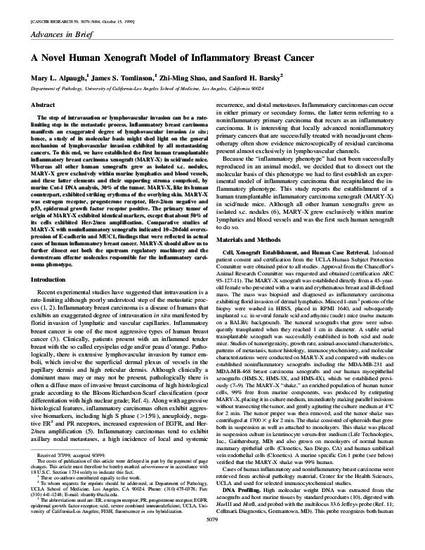
Article
A novel human xenograft model of inflammatory breast cancer
Cancer Research
(1999)
Abstract
The step of intravasation or lymphovascular invasion can be a rate-limiting step in the metastatic process. Inflammatory breast carcinoma manifests an exaggerated degree of lymphovascular invasion in situ; hence, a study of its molecular basis might shed light on the general mechanism of lymphovascular invasion exhibited by all metastasizing cancers. To this end, we have established the first human transplantable inflammatory breast carcinoma xenograft (MARY-X) in scid/nude mice. Whereas all other human xenografts grew as isolated s.c. nodules, MARY-X grew exclusively within murine lymphatics and blood vessels, and these latter elements and their supporting stroma comprised, by murine Cot-1 DNA analysis, 30% of the tumor. MARY-X, like its human counterpart, exhibited striking erythema of the overlying skin. MARY-X was estrogen receptor, progesterone receptor, Her-2/neu negative and p53, epidermal growth factor receptor positive. The primary tumor of origin of MARY-X exhibited identical markers, except that about 50% of its cells exhibited Her-2/neu amplification. Comparative studies of MARY-X with noninflammatory xenografts indicated 10-20-fold overexpression of E-cadherin and MUC1, findings that were reflected in actual cases of human inflammatory breast cancer. MARY-X should allow us to further dissect out both the upstream regulatory machinery and the downstream effector molecules responsible for the inflammatory carcinoma phenotype.
Disciplines
Publication Date
October 15, 1999
Citation Information
Mary L. Alpaugh, J. S. Tomlinson, Z. M. Shao and S. H. Barsky. "A novel human xenograft model of inflammatory breast cancer" Cancer Research Vol. 59 Iss. 20 (1999) p. 5079 - 5084 Available at: http://works.bepress.com/mary-alpaugh/1/
